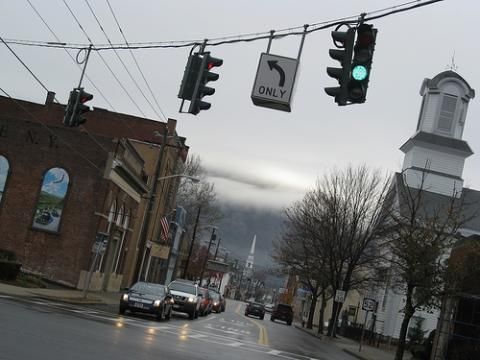
The town of Ellenville in Ulster County. Photo by Flickr user Karen Blumberg.
Earlier this month, the Daily Yonder, the blog about rural issues, published an interview with three experts on small towns: Bart Finzel, Jane Leonard, and Dave Engstrom. While the discussion was focused on Minnesota, which boasts an academic Center for Small Towns, the more general comments about a small town's odds for survival these days should strike a chord with residents of hamlets and villages in the Catskills. A few of the comments from the discussion are below:
On the forces that threaten small towns:
Engstrom: From my observation, the biggest systemic threat is related to population decline, and specifically among younger age groups. As the population in small cities declines and grows older, there is less consumer activity, causing a decline in retail business. Also, school districts with fewer students fuel the local economy less. It’s a vicious cycle once it starts. The decline in retail and business activity leads to a glut of Main Street retail buildings, which drives down property values and eventually leads to a decreased tax base.
On what helps a small town survive:
Leonard: How young people are regarded by a community is key. If enough people hold a mindset that young people don’t have a future in their small town and that belief is instilled from an early age, then the town is on a downward spiral. If kids are embraced, supported and encouraged to be a part of the community’s present and future, then that community is investing in its own future.
On the surprising disconnect between rural and urban places:
Finzel: As a professor in a small town, I find it remarkable to witness students with urban sensibilities truly connect with the realities of rural places. Some students are empowered by the connection. Others go home.
Students from urban areas take 24-hour shopping, a Walmart or Target, a cinema multiplex and a variety of dining opportunities for granted. Moreover, as their family ties to rural areas have lessened with each generation, their knowledge of small places and their ability to imagine a life without urban amenities have diminished.
After a time, urban students who stick it out find that those in small towns make the most of their limited menu of options: friends cook for one another and create their own entertainment; problems are solved by coming together, rather than making a phone call to a service provider; goods and services are provided by local sole proprietors, barter or not at all. Students learn that nothing can be taken for granted in a small community. Doing for oneself and one’s community is necessary. A sense of shared responsibility is cultivated.
On whether small towns will ever be popular places to live again in this country.
Small towns that exist because they provide essential services are, I suspect, unlikely to make a comeback because major services will continue to migrate to regional centers. But small towns that are built on a set of shared beliefs or aspirations, be it a desire for sustainable communities or the chance to fully engage in all aspects of a community, will be attractive in the future. This depends critically on leaders gathering residents together to articulate a shared vision. It will also depend on whether the town welcomes newcomers, creates opportunities for retirees to return and fosters a degree of promise in the future.
The advantages of small-town life—the cheap and abundant housing stock, the community’s role in child rearing, the relative security of knowing your neighbors, the opportunities for self determination and self-expression—will continue to be attractive to some. My thinking is that we are near bottom in terms of out-migration from small communities.













